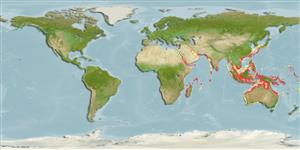Common names from other countries
Environment: milieu / climate zone / depth range / distribution range
экология
морской; пресноводный; солоноватоводный демерсальный. Tropical
Indo-West Pacific: Persian Gulf to the Indo-Malayan region, northern Australia, Queensland, and north to southern Japan. Has long been confused with Arius thalassinus (Rüppell 1837).
Size / Вес / Возраст
Maturity: Lm ? range ? - ? cm
Max length : 90.0 cm TL самец/пол неопределен; (Ref. 114032)
колючие лучи спинного плавника (общее число) : 1; колючие лучи анального плавника: 0; членистые (мягкие) лучи анального плавника: 17 - 21; позвонки: 53 - 58. Dorsomedian head groove bordered posteriorly by slightly raised frontals and forming a "V". Gill rakers usually absent on hind aspect of first 2 gill arches. Caudal fin lobes slender and tapered. Adipose fin short-based and located posteriorly.
Inhabits coastal waters, from estuaries onto the continental shelf. Found mostly on mudflats; males incubate eggs in its mouth (Ref. 68964). Mainly opportunistic and carnivorous; feeding on sea urchins, crustaceans, fish, prawns, loose scales, and detritus (Ref. 38478). Has a sharp and venomous dorsal and pectoral spines that can inflict extremely painful injuries(Ref. 68964). An important food fish (Ref. 7050).
Life cycle and mating behavior
Maturities | размножение | Spawnings | Egg(s) | Fecundities | личинки
Kailola, P.J., 1999. Ariidae (=Tachysuridae): sea catfishes (fork-tailed catfishes). p. 1827-1879. In K.E. Carpenter and V.H. Niem (eds.) FAO species identification guide for fishery purposes. The living marine resources of the Western Central Pacific. Vol. 3. Batoid fishes, chimaeras and bony fishes part 1 (Elopidae to Linophrynidae). FAO, Rome. (Ref. 38478)
Статус Красного Списка МСОП (Ref. 130435)
CITES (Ref. 128078)
Not Evaluated
Угроза для людей
Traumatogenic (Ref. 58010)
Использование человеком
рыболовство: не имеет хозяйственного значения
дополнительная информация
инструменты
Специальные отчеты
Скачать в формате XML
ресурсы в Интернет
Estimates based on models
Preferred temperature (Ref.
115969): 24.6 - 29.2, mean 28.3 (based on 1456 cells).
Phylogenetic diversity index (Ref.
82804): PD
50 = 0.6250 [Uniqueness, from 0.5 = low to 2.0 = high].
Bayesian length-weight: a=0.00813 (0.00384 - 0.01719), b=3.06 (2.88 - 3.24), in cm Total Length, based on LWR estimates for this (Sub)family-body shape (Ref.
93245).
Trophic level (Ref.
69278): 3.8 ±0.49 se; based on food items.
устойчивость к внешним воздействиям (Ref.
120179): низкий, минимальное время удвоения популяции 4.5-14 лет (Preliminary K or Fecundity.).
Fishing Vulnerability (Ref.
59153): High vulnerability (56 of 100).
